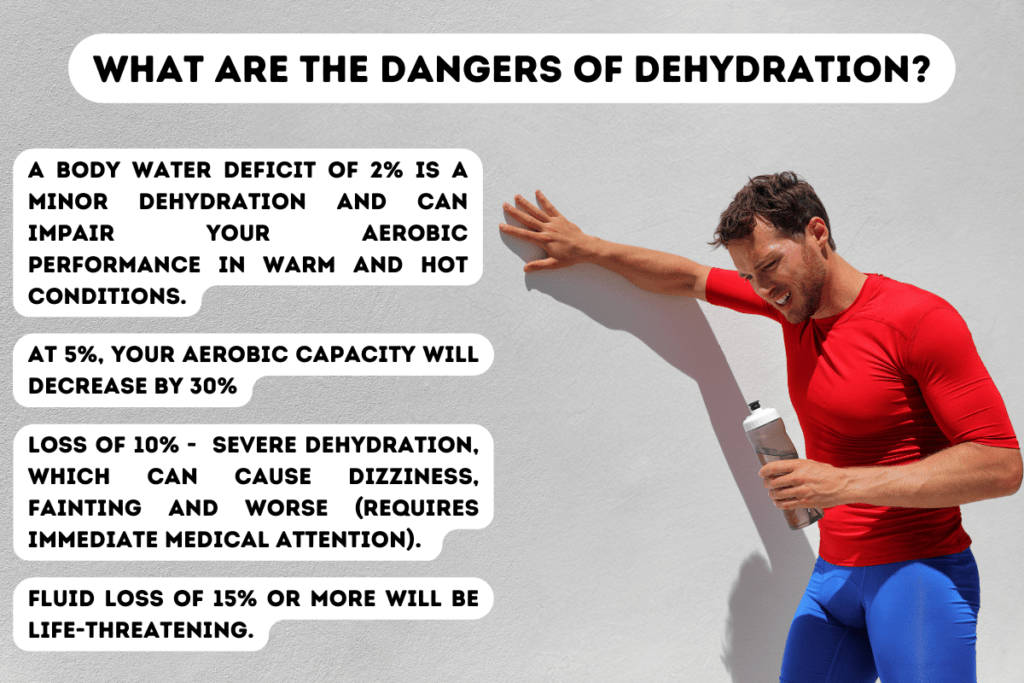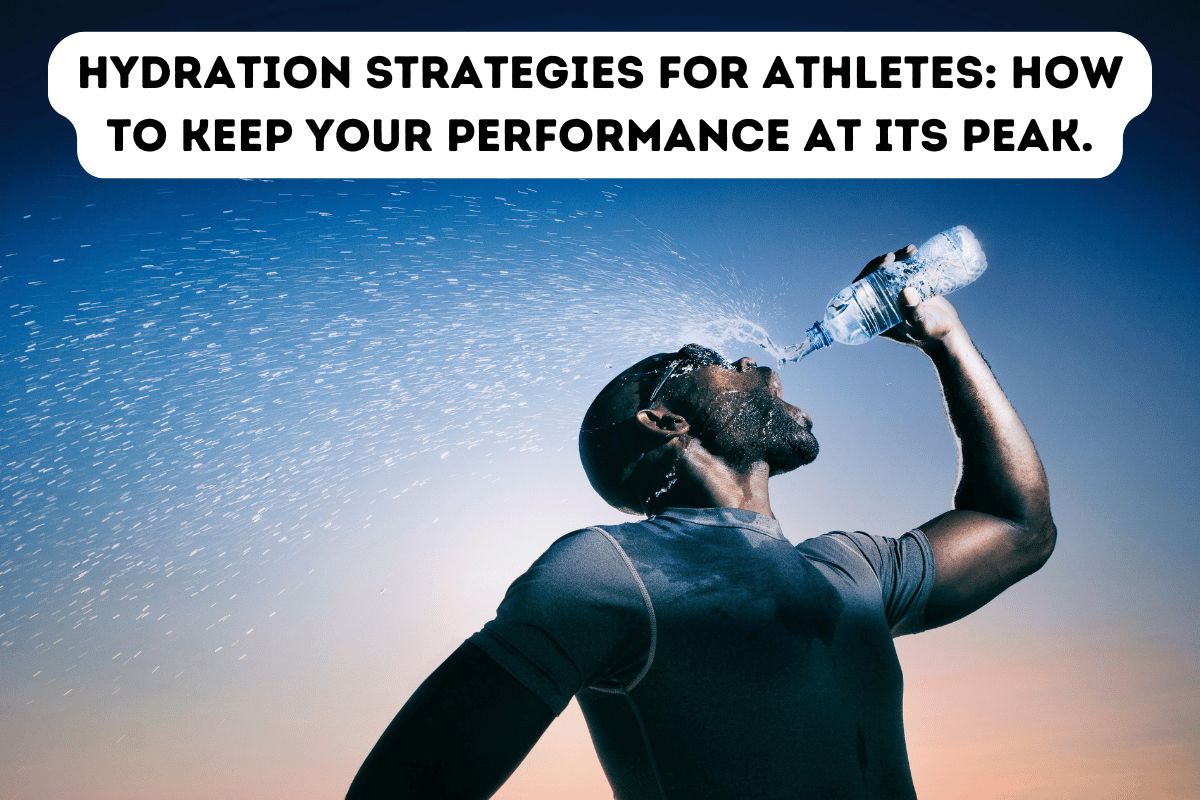Water in our body has many functions, such as temperature regulation and transportation of nutrients and waste throughout the body (as a component of blood). It is especially essential to drink enough water during exercise. Whenever you exercise, you lose fluid, not only through sweating but also through water vapour in the air that you breathe out. During high-intensity exercise in hot, humid conditions, your body’s fluid losses can be very high, and if the fluid is not replaced quickly, dehydration will follow. This dehydration will hurt your physical and mental performance, but it can be avoided, or at least minimized, by appropriate drinking strategies. Adequate fluid intake is essential for comfort, performance, and safety. The more prolonged and intense your exercise, the more important it is to drink the correct quantity and type of fluids.
In the previous article: “All you need to know about your water requirements”, we already discussed water functions in our bodies, how much water we need, what is dehydration, how to avoid it, and what are water requirements. In this article, we will discuss the effect of dehydration on performance in more detail, how to reduce the risk of dehydration and overhydration (hyponatraemia), when is the best time to drink, and how much to drink. We will discuss what fluids you must consume before, during, and after exercise. Finally, in this article, we will look at the effects of alcohol and caffeine on sports performance and health.
WHY DO YOU SWEAT?
First, let us consider what happens to your body when you exercise. When your muscles start exercising, they produce extra heat, which is why exercise makes you feel warmer. This extra heat has to be dissipated to keep your inner body temperature within safe limits—around 37–38°C. If your temperature rises too high, normal body functions are upset, and eventually, heat stroke can result. The main method of heat dispersal during exercise is sweating (sweating helps to cool down your body’s temperature).
The amount of sweat you produce and, therefore, the amount of fluid you lose depends on how hard you exercise, how long you are exercising, the temperature and humidity of your surroundings, and individual body chemistry. The harder and longer you exercise, and the hotter and more humid the environment, the more fluid you will lose. The more you sweat, the more care you should take to avoid dehydration. You can estimate your sweat loss and how much fluid you should drink by weighing yourself before and after exercise. Every 1 kg decrease in weight represents a loss of approximately 1 litre of fluid.
DO YOU NEED A SWEAT SUIT TO LOSE FAT?
Many athletes use sweatsuits, plastic, and other clothing to ‘make weight’ for competition. Other people are also trying to lose body fat by wearing sweatsuits. But are they effective? The short answer is NO. Sweat suits can help you to lose more water to make weight for competition, but they will not help you to lose excessive fat.
Moreover, sweatsuits can be dangerous for your health. Sweatsuits prevent sweat evaporation, which causes the body temperature to rise more and more. To expel this excess heat, your body will continue to produce more sweat. This process will increase the amount of fluid loss and will lead to dehydration. So, wearing a sweatsuit has no effect on fat loss and is also dangerous for your health. Any weight loss that will happen will simply be fluid, which will be regained immediately when you next eat or drink.
WHAT ARE THE DANGERS OF DEHYDRATION?
A body water deficit of 2% BW is generally defined as hypohydration or minor dehydration and can impair aerobic performance in warm and hot conditions (has less impact on performance in cool conditions). During dehydration, your blood volume decreases, and body temperature rises, which places extra strain on the heart, lungs and circulatory system, which means the heart has to work harder to pump blood around your body. The strain on your body’s systems means that exercise feels much harder, you will fatigue earlier and your performance drops. Hypohydration also leads to mental fatigue, a drop in concentration and low mood.
A drop in anaerobic or high-intensity activities performance in cool weather usually occurs once you have lost 3–5% of BW. If you lose 4%, you may experience nausea, vomiting and diarrhoea. At 5%, your aerobic capacity will decrease by 30%, while an 8% drop will cause dizziness, laboured breathing, weakness, and confusion. Greater drops have severe consequences.

You can prevent your body from becoming dehydrated by offsetting fluid losses as far as possible. The best way to do this is to ensure you are well-hydrated before you start exercising and to drink adequate fluids (according to your thirst) during and after exercise.
HYDRATION BEFORE, DURING AND AFTER EXERCISING.
Before exercises.
Before exercise, ensure you are well hydrated. If you begin a training session or competition in a dehydrated state, your performance will suffer, and you will be at a competitive disadvantage. Ensure you are well-hydrated before exercising, especially in hot and humid weather. The easiest way to check your hydration status is by monitoring the colour and volume of your urine.
Drinking 400–600 ml of fluid during the two hours before exercise is recommended to promote hydration and allow enough time to excrete excess water. But do not force yourself to drink so much that you gain weight. Over-drinking before and during exercise can lead to the risk of water intoxication. And if you plan to exercise at a high intensity for longer than one hour, you may benefit further from a sports drink. The additional carbohydrate may help maintain blood glucose levels during the latter stages of your workout. But this strategy should be used already during exercise.
During exercise
As soon as you start exercising, you will begin to lose fluid, so you aim to offset fluid losses by drinking early and at regular intervals. Do not force yourself to drink. It’s better to drink when you’re thirsty or drink only to the point at which you’re maintaining your weight, not gaining weight.
During low or moderate-intensity activities such as easy-pace swimming, cycling, or power walking, which last less than an hour, fluid losses are likely to be relatively small. They can be replaced fast enough with plain water. Drinking sports drinks compared with water during these types of activities offers little benefit.
For more than an hour-long exercise, drinking a sports drink containing up to 8 g sugar/100 ml rather than water may benefit your performance. During such activities, you need rapid fluid replacement and fuel replacement (carbohydrates). In other words, you need to avoid early glycogen depletion and low blood sugar, as well as dehydration, as all three can result in fatigue. So, consuming between 20–60 g carbohydrates/hour is necessary to maintain blood sugar levels and delay fatigue. You can find more about carbohydrate consumption for an athlete in my article: “The importance of carbohydrates for sports performance”.
For high-intensity exercises lasting more than two hours, you will need 40-80g of carbohydrates/hour to maintain blood sugar levels. And in this scenario, when you are exercising longer than 2 hours or sweating very heavily, you should choose a sports drink that also contains sodium to maintain your electrolyte balance. Drinking such electrolyte/carbohydrate drinks during more than 2 or even 3-hour training sessions will help to avoid hyponatraemia, maintain better fluid levels in the body, spare muscle glycogen and delay fatigue. More about electrolytes and hyponatraemia will be discussed below.
After exercise
To restore normal fluid balance after exercise, researchers recommend you should consume approximately 1.2–1.5 times the weight of fluid lost during exercise. The simplest way to work out how much you need to drink is to weigh yourself before and after training. Working on the basis that 1 litre of sweat is roughly equivalent to a 1 kg body weight loss, you need to drink 1.2–1.5 fluid for each kg of weight lost during exercise.
Don’t drink the whole amount of fluid straight away, consume as much as you feel comfortable with, then drink the remainder in divided doses until you are fully hydrated. Sports drinks may be better than water at speeding recovery after exercise, mainly when fluid losses are high or for those athletes who train or compete twice a day. Also, research suggests that skimmed milk may be an even better option for promoting post-exercise rehydration. This is because we get protein, carbohydrates, and liquid at the same time with milk. In the same way, any carbohydrate-protein drink will benefit you better after exercise than just water alone.
SPORTS DRINKS AND STOMACH CRAMPS.
In some people, sports drinks can cause cramping and discomfort during exercise. This can happen because more concentrated drinks empty more slowly from the stomach and are absorbed more slowly from the intestines, which can lead to discomfort in your stomach. This problem can be solved by diluting sports drinks with water. Although, diluted sports drinks will give you fewer carbohydrates, so you need to find a balance between obtaining enough carbohydrates to fuel your exercise and avoiding GI discomfort. The best solution here is just to experiment with different sports drinks and find which suits you best.
WHAT IS WATER INTOXICATION OR HYPONATRAEMIA?
Water intoxication or hyponatraemia is very rare in sedentary or mildly active people but sometimes happens in long-distance runners who consume a lot of water and lose a lot of salt through sweat. From over-hydration (drinking too much water) you can die. When you drink too much water, the water content of the blood increases, and the salt content is diluted. This dilutes your electrolytes, which is worsened by the fact that you already losing electrolytes in your sweat. Consequently, the amount of salt available to body tissues decreases, leading to problems with brain, heart, and muscle function and can lead to collapse or coma. Initial symptoms of over-hydration include dizziness, nausea, bloating, lapses in consciousness and seizures due to swelling of the brain. However, these symptoms are also associated with dehydration, so it’s essential to be aware of how much you are drinking.
THE DIFFERENCE BETWEEN HYPOTONIC, ISOTONIC, AND HYPERTONIC DRINKS.
Sports drinks are designed to help sports people rehydrate when fluids are depleted after training. They help to provide the body with necessary fuels such as carbohydrates, electrolytes, and water. All these are important in delaying fatigue during exercise or helping to recover. We need carbohydrates in sports drinks for two main reasons: to speed up water absorption and to provide an additional energy source. As the primary source of fuel, carbohydrates help maintain blood sugar levels and glycogen stores so that people can exercise more effectively for longer. In addition to providing fuel, the sugars increase the palatability of the sports drink and encourage athletes to drink more.
As to electrolytes, they are mineral salts that include sodium, chloride, potassium, and magnesium, and help to regulate the fluid balance between different body compartments. For example, electrolytes control the amount of fluid inside and outside a muscle cell and the volume of fluid in the bloodstream. If there is an increase in the concentration of sodium outside a cell, this will cause water to move from inside the cell to outside of the cell. Similarly, a drop in sodium concentration outside of the cell will cause water to move from the outside to the inside of the cell. All in all, this process is critical and if we dilute electrolyte concentration in the body too much it will lead to water intoxication or hyponatraemia, which we discussed earlier. Also, sodium increases the urge to drink and improves palatability. Now, let’s speak about what are the three main types of sports drinks according to osmolality:
Hypotonic drinks. Hypotonic drinks are designed to maintain hydration. They have relatively low osmolality, which means they contain smaller amounts of carbohydrates and electrolytes per 100 ml than the body’s own fluids (hypotonic drinks contain less than 4 g carbohydrate/100 ml). As hypotonic drinks are more dilute, they are absorbed faster than plain water and are ideal for rehydrating. However, they will not provide sufficient fuel for a long workout.
Isotonic drinks. Isotonic drinks will provide you with carbohydrates and help to maintain hydration. Isotonic drinks are typical sports drinks that have the same osmolality as the body’s fluids and are absorbed faster than plain water. Most isotonic drinks contain between 4 and 8 g of carbohydrates/100 ml and can provide the ideal compromise between rehydration and refuelling.
Hypertonic drinks. Such drinks are used to supply carbohydrates (such as soft drinks and fizzy drinks) and have a higher osmolality than body fluids (containing more than 8 g carbohydrate/100 ml). Because such drinks contain more carbohydrates and electrolytes per 100 ml, they are more concentrated and absorbed more slowly than plain water. Hypertonic sports drinks are best used after exercise for refuelling rather than rehydrating.
CAN YOU MAKE YOUR OWN SPORTS DRINK?
Definitely! Commercial sports drinks can be very expensive, and sometimes, it is just more convenient to make your own sports drink. All you need to do is add some sugar and salt to the water, or take your favourite fruit juice and dilute it with water. The table below shows some recipes for making your own sports drink.
| Hypotonic | Isotonic |
| 20–40 g sucrose + 1 L warm water + 1–1.5 g (1⁄4 tsp) salt (optional) + Sugar-free/low-calorie squash for flavouring (optional)100 ml fruit squash + 900 ml water + 1–1.5 g (1⁄4 tsp) salt (optional)250 ml fruit juice + 750 ml water + 1–1.5 g (1⁄4 tsp) salt (optional) | 40–80 g sucrose + 1 L warm water + 1–1.5 g (1⁄4 tsp) salt (optional) + Sugar-free/low-calorie squash for flavouring (optional)200 ml fruit squash + 800 ml water + 1–1.5 g (1⁄4 tsp) salt (optional)500 ml fruit juice + 500 ml water + 1–1.5 g (1⁄4 tsp) salt (optional) |
CAFFEINE-CONTAINING ENERGY DRINKS AND ALCOHOL.
First, let’s start with caffeine. Caffeine is found in many drinks and foods such as coffee, tea, cola, and chocolate. It is also added to several energy drinks, sports drinks, and gels. Caffeine acts on the central nervous system, increasing alertness and concentration, which is advantageous for many sports. The best way to use caffeine is to cut down on it for several days before training or competition to get a better ergogenic effect. Then, immediately before exercise, take approximately 150–200 mg of caffeine from strong coffee or an energy/sports drink. This will help you to keep exercising longer and harder. So, caffeine is beneficial for your training and performance, but don’t forget that caffeine is a diuretic, and you should drink more water afterwards. More about caffeine you can read in my article: “All you need to know about caffeine“. Also, I have an article about the main sport supplement that you may need to improve your sports performance and there is information about caffeine as well. If interested, you can find this article here.
As to alcohol, it’s not the best idea to drink it before training or competition. Drinking alcohol before exercise can make you feel more alert and confident. However, alcohol is more of a depressant rather than a stimulant. It reduces your coordination skills, is potentially toxic to all the cells and organs in your body, and, if it builds up to high concentrations, it can cause damage to the liver, stomach and brain. The negative effects of alcohol on performance include:
• Reduced coordination, reaction time, and balance.
• Reduced strength, power, speed, and endurance.
• Reduced ability to regulate body temperature.
• Reduced blood sugar levels and increased risk of hypoglycaemia.
• Increased water excretion (urination) and the risk of dehydration.
• Increase risk of accidents or injuries.
More about alcohol in my article: “All you need to know about alcohol“.
CONCLUSION.
All in all, proper hydration for athletes is very important for physical and mental performance. During high-intensity exercise, especially in hot, humid conditions, your body’s fluid losses can be very high and, if the fluid is not replaced quickly, dehydration can occur which will negatively affect your performance. If you drink too much water, you can dilute your electrolytes and get water intoxication. If you don’t provide enough carbohydrates during high-intensity training, lasting more than an hour, your performance will drop because of low glycogen stores in your muscles. If you are drinking hypertonic during training (which contains more than 8 g carbohydrate/100 ml), it will be absorbed more slowly and can give you stomach cramps. All these things are essential to understand and use proper hydration strategies. I hope you liked the article. Don’t forget to hydrate your body properly to avoid dehydration and always have excellent physical performance results.




